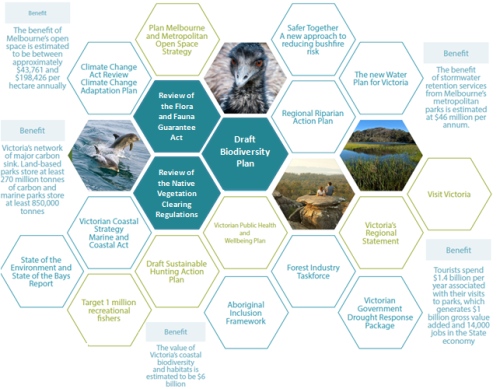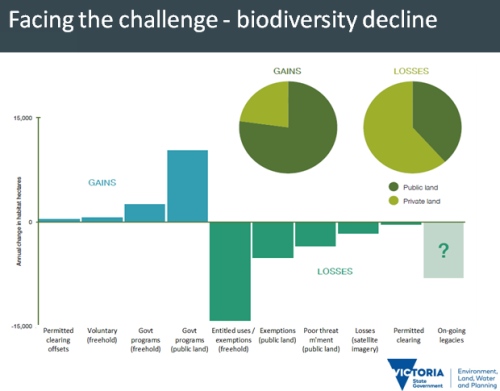Video conf. notes 28 April 2016 - LGA biodiversity
SWIFFT video conference notes are a summary of the video conference and not intended to be a definitive record of presentations made and issues discussed.
This video conference was supported through resources and technology provided by the Department of Environment, Land, Water and Planning, Victoria. SWIFFT wishes to thank speakers for their time and delivery of presentations.
The second video conference for 2016 had a theme on Biodiversity Conservation through Local Government.
Groups/organisations in attendance
A total of 67 participants were connected across 13 locations; Ballarat, Bendigo, Colac, Geelong, Hamilton, Heywood, Heidelberg (Arthur Rylah Institute), Horsham, Knoxfield, Mildura, Melbourne (Nicholson Street), Traralgon and Wodonga.
Educational: Federation University - Australia.
Local Government: Melton Shire, Nillumbik Shire, Macedon Ranges Shire, Yarra Ranges Shire, Pyrenees Shire, City of Hume, Wellington Shire, Mornington Peninsula Shire.
Field Naturalist Clubs: Ballarat, Geelong, Portland, Hamilton.
Community Conservation Groups: Ballarat Environment Network, Friends of Buckley Falls, Friends of Brisbane Ranges, Friends of Eastern Otways/ANGAIR.
Conservation Organisations: Barwon Coast Committee of Management, Parks Victoria, Department of Environment, Land, Water and Planning (DEWLP) staff across 13 locations, inc. Nicholson Street Melbourne, Knoxfield and Arthur Rylah Institute, Heidelberg.
Industry: Brett Lane & Associates
KEY POINTS SUMMARY Quick take home messages from this video conference or read through the speaker summaries.
- Macedon Ranges biodiversity program
- SWIFFT web site redevelopment
- Victoria's Biodiversity Plan
- Local Government Planners Network
SPEAKER SUMMARIES
Threatened species monitoring program at Macedon Ranges Shire - William Terry, Environmental Programs and Education Officer, Macedon Ranges Shire.
William has a background in ecology and had previously studied the Pink-tailed Worm Lizard. He is now involved in the fauna monitoring program of the Shire's conservation reserves.
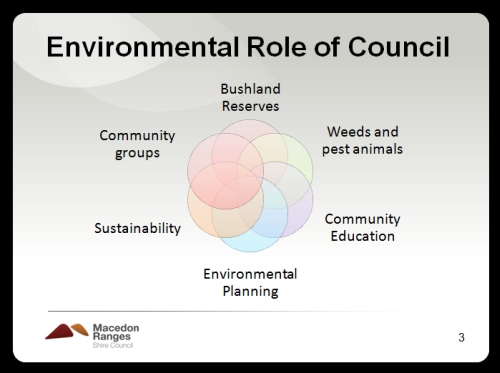
William spoke about the Shire's environmental role which spans management of the Shire's bushland reserves, environmental planning, sustainability, weed & pest animals, community groups and community education.
He described how the Macedon Ranges Shire includes some high quality areas of public land in the Lerderderg State Park, Macedon Ranges Regional Park and Mt Charlie Flora Reserve as well as areas of native vegetation on private land.
Council conservation reserves
The council has several high quality bushland reserves which are managed for their conservation values. These reserves were created in the past as council purchased hill top areas to maintain the scenic landscape of the Shire and prevent unwanted development.
Environmental Management Plans are used to determine best practice management and drive initiatives. Very few fauna surveys have been undertaken in the reserves but new species are continuously being discovered.
Monitoring programs
William spoke about the need to undertake monitoring. It is important to know what species exist in order to protect and manage them.
Flora monitoring & planning
Macedon Ranges Shire is working to redevelop Black Gum Vegetation Overlays to ensure better protection of this EPBC listed species. There is ongoing monitoring and recording of threatened plants on roadsides such as Matted Flax-lily and Clover Glycine.
The shire is also in the process of developing a Roadside Management Plan and Biodiversity Strategy.
Fauna monitoring program

The fauna monitoring program involves using a range of methods to detect fauna and maintain consistent records.
Nest boxes: 300 nest boxes have been installed in the last 12 months, these were built through the Men's Shed using a design from Zoos Victoria, targeting Brush-tailed Phascogales, Sugar Gliders and Feathertail Gliders. Community groups are heavily involved with the ownership and monitoring of nest boxes.
Remote cameras: the shire has 8 Hyperfire remote cameras which are in constant use, they have been used in 20 dedicated camera surveys.
Spotlighting: a spotlighting survey is carried out at each reserve once per year which aims to detect species which do not readily show up in camera surveys such as Greater Gliders and Koalas. Powerful owls were recently detected at Hanging Rock which is good news as they had not been recorded there for some years.
Reptiles and amphibians: surveys are undertaken once per year. Artificial refuges using tiles and sheet iron are set up at some reserves as part of long term monitoring. Detection of the Brown Toadlet at Bald Hill Reserve was significant as it had not been recorded in the area for over 20 years.
Birds: annual bird surveys are conducted through a partnership with the local bird observers group and Birdlife Australia.

Results from one year of nest box survey

William noted that Sugar Gliders seem to adapt well to nest boxes. Phascogales only equate to 10% usage but it is thought that this will increase over time.
Surveys are also being carried out using other methods e.g. scats, owl pellets and fox scats to determine their presence in the reserves.
Community involvement
The program involves about 40 Landcare groups across the Shire.
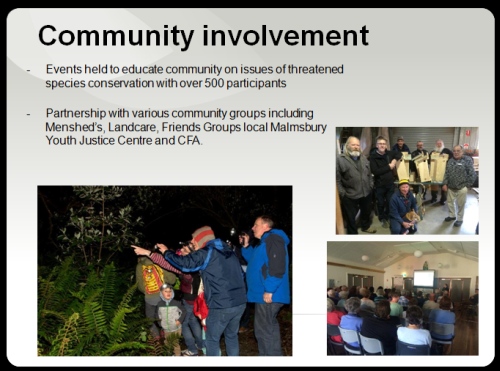
Benefits of this program
- Improved baseline understanding of species present
- Ability to evaluate the impact of intervention /management
- Community engagement
- Identify opportunities for complimentary conservation programs e.g. wildlife corridors, private land habitat management.
Fox control and Phascogale research project
The purpose of the research was to better understand implications of a 1080 baiting program including costs/benefits, community risks and off-target impacts.
Other studies have shown that Phascogale can consume 1080 baits laid for foxes but it is unclear if they were digging these baits up or if they were taken from fox caches. If the means of up-take by phascogales could be determined the off-target impacts could be minimised significantly.
A free feed experiment was conducted to see fauna interactions with the baits (non poisonous baits). Sixteen free feed stations were set up in 2 reserves, each with a known occurrence of phascogales. These were monitored with remote cameras for 3 weeks to simulate a fox baiting program and records taken every 24 hours.

Results indicate that off-target impacts would be very low but caching of baits by foxes could still be a threat. The use of softer baits could overcome this problem as softer baits result in more direct eating and less caching.
Key points from questions
- More free feed trials will be conducted at different times of the year as the time of year could influence bait take by reptiles.
- After a fire at Black Hill Reserve there was a reduction in Phascogale numbers but they are still present and seem to reoccupying the area.
- The issue of fox movement over large areas could negate any fox control programs at small reserves.
-
The Shire is still considering its position on fox control baiting on small reserves. A decision will be made after all the free feeding trials are evaluated.
Update on SWIFFT web site redevelopment & mapping portal - Rob Milne, Centre for eResearch & Digital Innovation (CeRDI), Federation University - Australia.
Rob spoke about progress towards development of the SWIFFT web site and Visualising Victoria's Biodiversity mapping portal. He said CeRDI is focused on providing web applications to visualise data and share knowledge.
SWIFFT web site
Feedback from stakeholders has lead to a redesign of the way people will be able to access information. Key changes to be introduced soon will be a new front page design featuring a search by mapping and a new search by text that will display results in a thematic way.
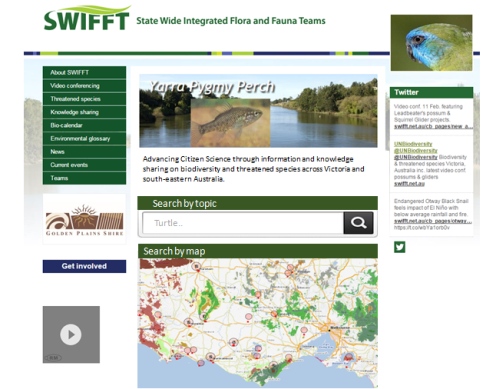
Results from text searches will also be developed to include data from other resources e.g. Atlas of Living Australia, Federal Dept. of Environment.

Spatial searching will enable users to search for biodiversity projects, flora &fauna records, research etc. It will also provide opportunity for people running projects to have their project included and share what they are doing. Spatial searching will also enable easy access to threatened fauna & flora data by Local Government Area.

Visualising Victoria's Biodiversity mapping portal
Rob spoke about development of the VVB and the opportunities to include a diverse number spatial layers, particularly as the sharing of data is becoming more readily available through data sharing agreements.
Key points from questions
- SWIFFT currently has threatened fauna lists x LGA but only access via the main menu. The new changes will display this information via a map. LGA Lists
- Obtaining species lists for areas will be primarily be delivered through the Victorian Biodiversity Atlas. In time, this type of functionality could be available through Visualising Victoria's Biodiversity.
- As the concept of open data grows it will be possible to incorporate much greater sharing of data both into and out of the VVB.
A draft long-term plan for managing Victoria's biodiversity - "Protecting Victoria's Environment - Biodiversity 2036" - Vanessa Craigie (DELWP)
Vanessa provided an overview of what has happened to-date in development of the Biodiversity Plan and the process going forward to release of the final plan late 2016.
Vanessa said the Biodiversity Plan was an election commitment. The process builds on previous work where relevant (e.g. Land and Biodiversity White Paper, draft Biodiversity is Everyone's Business and draft Threatened Species Strategy) and has involved an extensive number of portfolio and stakeholder reference groups.
A draft was released on 17 April 2016 and open for consultation to 15 May 2016.
Purpose of the plan
Create the case for “biodiversity” that places it in the mainstream for Victoria and identifies the most important steps for everyone to take so we have a healthy world to live in.
Context
Vanessa spoke about where the biodiversity plan fits in with a number of other strategic review which are being undertaken at present. In particular review of the Flora & Fauna Guarantee Act, Review of the Native vegetation Clearing Regulations, Plan Melbourne, Water Plan for Victoria, Tourism and State of the Environment.
Making the case for biodiversity
Vanessa spoke about some of the reasons why there is a need to recognise the importance of biodiversity.
- Biodiversity is part of our identity
- Victoria’s natural environment is fundamental to the wellbeing of every Victorian
- Victoria’s natural environment is our biggest tourist attraction
- Being in nature is good for our minds and bodies
- Biodiversity can help reduce the impacts of climate change, not only by sequestering carbon
- Victoria’s biodiversity is the foundation of our healthy ecosystems
Economic value of the environment
Vanessa spoke about the concept of natural capital and how a decline in our environment can result in a loss of economic growth. She pointed out that a rebuilding of natural capital from where we are now could provide an extra $15-36 billon to Victoria's economy into the future.
Gains and losses in native vegetation
Vanessa said the gains in native vegetation off-sets are pretty much balanced out against the losses of permitted clearing but these are relatively small compared to other processes. The biggest gains come from Government programs related to Public Land but the really big losses comes from activities not covered by the regulatory system occurring on private land e.g. as of right clearing, illegal clearing etc.
Vision, goals and objectives
Vanessa spoke about the plan and how measurable objectives fit into the goals and vision.
Vision: That Victoria's biodiversity is healthy, valued and actively cared for.
- Goal 1: Encourage more Victorians to value nature
- Goal 2. Ensure that Victoria's natural environment is healthy
There are a number of measurable objectives relating to the above goals which are stated in the plan but at this stage the plan does not have specific targets. Broad targets will be included in the final plan.
Vanessa said this plan is different from the previous Biodiversity Strategy in that there is a strong focus on people and connection to nature. The plan also looks at 'linking our society and economy to the environment' through mechanisms such as environmental economic accounting which is embedded in the way business and government account for environmental assets.
The draft plan highlights the need to rectify many years of under resourcing and attain a sustainable funding model through boosting government investment, supporting more businesses to invest through a Regional Investment Prospectus and making it easier to protect biodiversity and tackle climate change, e.g. carbon credit market. Increased incentives for permanent protection of private land also feature.
Vanessa spoke about chapter 8 which deals with 'setting up a better system for managing our natural environment and dealing with climate change'.

A Strategic Management Prospectus will form part of future decision making by looking at how information is used to decide how and where to act to deliver best value for money.
Chapter 9 deals with 'Biodiversity leadership across government' which will place Victoria as a leader in this area once again. It ensures biodiversity is not tacked on but embedded in government decision making and programs. It also ensures evaluation and reporting on the effectiveness of targets and goals every 5 years through the Commissioner for Environmental Sustainability. The Biodiversity Plan will also be embedded in the Flora & Fauna Guarantee Strategy.
Input to the draft Biodiversity Plan
http://haveyoursay.delwp.vic.gov.au/biodiversity-plan
Other programs
Review of the Native Vegetation Clearing Regulations - Consultation closed on 29 April 2016
Water for Victoria: Input from 16 March to 13 May 2016, with the final Water Plan expected to be released in mid-2016.
http://haveyoursay.delwp.vic.gov.au/water-for-victoria
Review the Flora and Fauna Guarantee Act 1988 - Public Discussion paper – mid 2016
Key points from questions
There has not been enough emphasis on environmental education in the draft. The final plan will reflect a greater need for environmental education to be embedded in the school curriculum.
It appears there is a lack of co-ordination between the Biodiversity Plan and the Native Vegetation review. It is hoped the final plan will address this issue.
The lack of aspirational targets was raised which could lead to inefficient use of resources. This issues is being taken up with the Scientific Reference Group.
The issue of being able to deliver on high quality monitoring will require a significant investment in resources as the level of monitoring has fallen way behind in recent years.
The development of specific targets is still a work in progress as it is a complex issue involving targets for species, habitats, conservation status etc.
There is no intent that government is pushing away its responsibilities to the community regarding the Biodiversity Plan. The plan specifically refers to the State Government as being a leader in this area.
There could have been more involvement with business groups development of the plan.
Local Government Biodiversity Planners Network - Amanda Dodd, Co-Convenor (Western) Biodiversity Planners Network & Environmental Planning Coordinator, Hume City Council
Amanda spoke about the Biodiversity Planners Network which is formed under LGPro (Local Government Professionals) which has a number of Special Interest Groups where different areas of local government come together e.g. finance group, IT group etc.
Purpose of the Network
The Biodiversity Planners Network assists Local Government staff who implement biodiversity legislation and policies with the aim of contributing towards the protection and enhancement of natural values within their municipality and the State.
The network provides an avenue to discuss emerging issues, share knowledge and experience. The network also provides opportunities for professional development, peer support and communication with other policy groups. For example, implementing the Native Vegetation Framework and developing local policy.
History of the Network
The group started informally amongst local government officers in 2008 and became a formalised LGPro Special Interest Group in July 2012.
The network was established in response to a broadly experienced inconsistent support or information available to Local Government with regard to the Native Vegetation framework and Net Gain, particularly as Local Government has the responsibility to issue planning permits in relation to native vegetation and balance out all the other competing objectives.
Officers participating in the group include representatives from a number of Local Governments from in and around Melbourne including urban growth areas, urban and interface councils.
Members
Amanda said there are 83 members across 33 councils. The membership has been mainly located in and around Melbourne but is gradually including more regional participation into the network.
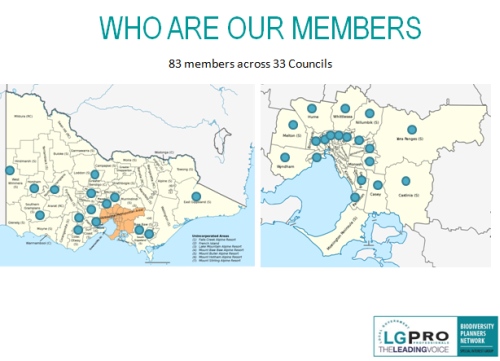
Blue dots indicate member councils.
Members are people working in Local Government who have one or more roles i.e.
- Environmental Planning
- Private Land Biodiversity Grants
- Environmental Enforcement and Compliance
- Bushland Managers
- Environmental Education.
Amanda noted that LGA's further out from Melbourne generally have less resources and roles can be a combination of planning/environmental planning and other roles.
Most people in the network come from a science education background and not necessarily planning. Many members have pre local government experience in one or more of State Government e.g. DELWP, Ecological Consultancy, Land Management Contractors, Research, Academia, Community Engagement and Not-for-Profits.
How the network operates
Meetings are held every two months. At present there is an eastern chapter and a western chapter. In future it is hoped to have a rural chapter set up. At present rural members attend one of the existing chapters.
There are two whole-of-network meetings each year. There are special meetings for topics/advocacy e.g. discussions re Biodiversity Plan. The network also provides a good support base for staff via phone and email. The network has collaborative discussions on issues and a place where members can view their opinions on how to deal with issues.
Network Achievements
- Increased understanding of how other Councils implement native vegetation regulations – in particular, exemptions.
- Increased consistency in implementation across Councils.
- Collaboration on cross-border biodiversity planning projects.
- Support and advice for planning decisions and preparing for VCAT hearings.
- Support and advice for environmental enforcement cases.
- Submissions to state government – including network submissions and assistance with individual council submission.
- Organising training.
- Assisting and providing advice on Bushfire Recovery Process.
- Connection to other ‘non biodiversity’ areas of local and state government (e.g. engineering, health, planning, education, social development).
- Providing a friendly ear to discuss complex cases.
Local Government & biodiversity conservation overview
Many people do not realise the role local government plays in achieving biodiversity outcomes. Amanda spoke about 8 LGA's as examples of how local government contributes to biodiversity not only through environmental planning but also through community engagement, environmental grants, education, threatened species recovery, bushland/grassland management, waterways, weed control and habitat protection through agricultural rebates.
Amanda provided a summary of biodiversity staffing relating to each of the 8 councils, budgets and priority programs.
Staffing varies greatly between councils and is usually a reflection of population, council commitment and funding capacity. Some of the councils have managed to supplement their funding by working with community groups in obtaining grants for various programs. It is also important to advocate to the local councillors for biodiversity funding.
The network is constantly trying to bridge the divide between research, policy and application. Amanda felt there a many gains to be made by including local government in planning and implementation of biodiversity related projects. The network is also fostering increased collaboration between state and local government.
Contact:
LGPro Biodiversity Planners Network
West - Amanda Dodd, Hume City Council
East - Melanie Birtchnell, Manningham City Council
Key points from questions
It is important to advocate to your local councillors for biodiversity funding.
It is important to remember there is a wide variety of people employed in councils who can contribute to biodiversity conservation provided they are of the right mindset.
Threatened fauna lists for most LGA's in Victoria are now on SWIFFT.
There is an opportunity for council biodiversity projects to be included in the Teams section of SWIFFT.
General discussion key points
There needs to be adequate funding in the Parks program to implement many of the actions required for threatened species management.
The issue of using baits to attract fauna to remote cameras was raised because baits can not only attract native species but also foxes. The dilemma is that non baited cameras are not as efficient as baited cameras. The key is to set up baits so they are less available to foxes and to ensure they can't feed off the bait but rather using a smell to attract them. Also don't leave baits with cameras in the same area for too long so as to prevent foxes lingering around.
Avoid using honey in the bait, glucose or essential oils being a more suitable option. The use of baited cameras requires Ethics Committee approval.
High numbers of foxes were detected in the Macedon Ranges camera surveys but very few cats.
There seems to have been a disconnect between development of the new Water Plan for Victoria and the Biodiversity Plan.
KEY POINTS SUMMARY
| Macedon Ranges Shire's environmental role spans management of the Shire's bushland reserves, environmental planning, sustainability, weed & pest animals, community groups and community education. |
| Macedon Ranges Shire works with the community to undertake fauna monitoring in the Shire's bushland reserves. |
| In the last 12 months 300 nest boxes were installed in Macedon Ranges Shire targeting Brush-tailed Phascogales, Sugar Gliders and Feathertail Gliders. |
| A draft Biodiversity Plan for Victoria was released on 17 April 2016 and open for consultation to 15 May 2016. Key goals; Encourage more Victorians to value nature and Ensure that Victoria's natural environment is healthy. |
| A decline in our environment can result in a loss of economic growth. A rebuilding of natural capital from where we are now could provide an extra $15-36 billon to Victoria's economy into the future. |
| The Biodiversity Planners Network is a valuable means of assisting Local Government staff in the protection and enhancement of natural values within their municipality and the State. |



